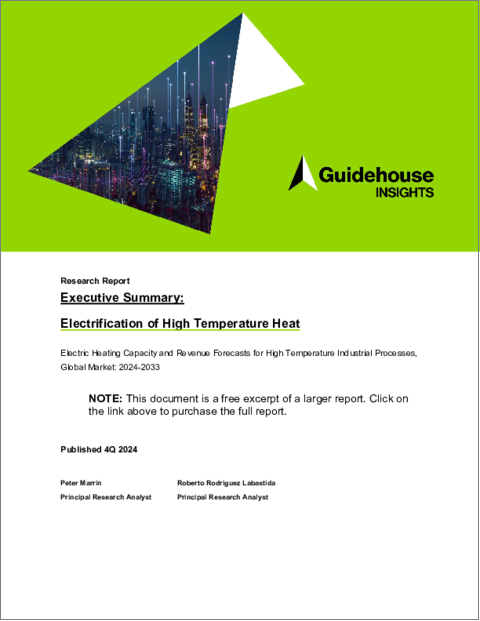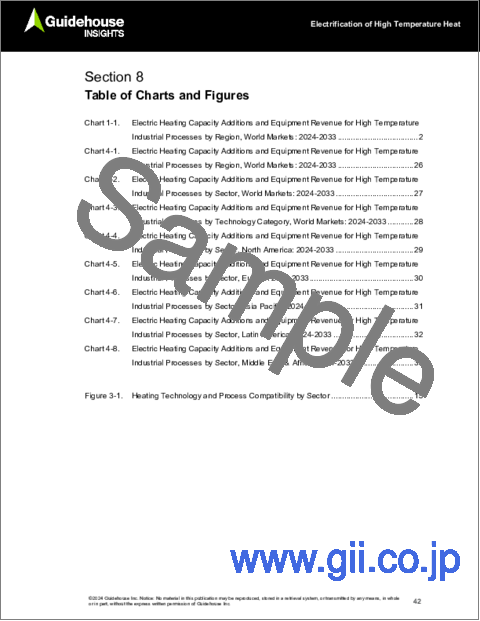|
|
市場調査レポート
商品コード
1596028
高温熱の電化Electrification of High Temperature Heat: Electric Heating Capacity and Revenue Forecasts for High Temperature Industrial Processes, Global Market 2024-2033 |
||||||
|
|||||||
| 高温熱の電化 |
|
出版日: 2024年11月22日
発行: Guidehouse Research
ページ情報: 英文 45 Pages
納期: 即納可能
|
全表示
- 概要
- 目次
工業用熱需要の約半分は、400℃以上で運転される熱プロセス用です。これらのプロセスは通常、鉄鋼、基礎化学品、セメント・石灰、非鉄金属、ガラス製造など、熱エネルギー需要のほとんどを化石燃料の燃焼に頼っている、熱効率の低下しにくいセクターで発生します。直接電化を大規模に実施することは、一般に、コストがかかりすぎ、既存のインフラを破壊しすぎ、技術的に困難であると考えられてきました。そのため、高温の熱を脱炭素化するためのアプローチは、炭素回収、水素、バイオマスといった燃焼ベースの経路に焦点が当てられることが多かっています。
しかし、高温プロセスの電化が産業界の脱炭素化を推進する重要な原動力になることを示唆する証拠も増えています。電気アーク炉での二次製鋼など、特定の高温プロセスでは、すでに電化が既定の選択肢となっています。電熱技術はまた、高度な温度制御を必要とする特殊材料の製造にも、小規模ながら一般的に使用されています。既存の用途にとどまらず、セメント、化学、その他のセクターにおけるパイロット・プロジェクトや実証プロジェクトは、技術的には、電化によって工業用熱需要の現在よりもはるかに大きな割合を満たすことができることを示しています。
直接電化の利点には、プロセス効率の改善、低炭素電力源の使用によるエネルギー関連排出の大幅削減、メンテナンスコストの低減などがあります。
当レポートでは、高温熱の電化について調査し、2024年から2033年までの高温工業プロセス向け電気加熱容量増設と機器収益の市場予測を掲載しています。予測は世界の地域別、分野別、技術開発段階別に区分しています。
目次
第1章 エグゼクティブサマリー
- 市場イントロダクション
- 市場予測
第2章 市場の問題
- 促進要因
- 産業電化に対する政策支援の強化
- 効率性の向上
- メンテナンスコストの削減
- 柔軟化の機会
- 燃料価格の変動
- 抑制要因
- 高い電気代
- 長い交換サイクル
- 技術の不確実性とプロセスの複雑さ
- 大規模負荷の系統接続確保の難しさ
- 政策
- 技術
- 抵抗加熱
- 赤外線加熱
- 誘電加熱
- 誘導加熱
- 電気アーク炉
- プラズマ技術
- 熱電池
- 衝撃波加熱
第3章 産業バリューチェーン
- セクター
- セメント・石灰
- 化学薬品
- ガラス
- 非鉄金属
- 製鉄
第4章 市場予測
- 範囲と調査手法
- 世界市場概要
- 地域別市場概要
- 北米
- 欧州
- アジア太平洋
- ラテンアメリカ
- 中東・アフリカ
第5章 結論・提言
第6章 頭字語と略語一覧
第7章 目次
第8章 図表
第9章 調査範囲、情報源と調査手法、注釈
Approximately half of industrial heat demand is for thermal processes that operate at temperatures above 400°C. These processes typically occur in hard-to-abate sectors such as iron and steel, basic chemicals, cement and lime, nonferrous metals, and glass production, all of which rely on fossil fuel combustion to supply most of their thermal energy needs. Implementing direct electrification at scale has generally been perceived as too expensive, too disruptive to existing infrastructure, and too technically challenging. Approaches to decarbonizing high temperature heat have therefore often focused on combustion-based pathways such as carbon capture, hydrogen, or biomass.
However, a growing body of evidence suggests that electrification of high temperature processes will be a key driver of industrial decarbonization. Electrification is already the default option for certain high temperature processes such as secondary steelmaking in electric arc furnaces. Electrified heating technologies are also commonly used at smaller scales for manufacturing specialty materials that require a high level of temperature control. Beyond existing applications, pilot and demonstration projects in cement, chemicals, and other sectors have shown that technically, electrification could satisfy a much greater share of industrial heat demand than it does today.
Advantages of direct electrification include improvements to process efficiency, significant reductions in energy-related emissions when using low carbon electricity sources, and lower maintenance costs. This Guidehouse Insights report provides market forecasts for electric heating capacity additions and equipment revenue for high temperature industrial processes from 2024 through 2033. Forecasts are segmented by global region, sector, and technology development stage.
Table of Contents
1. Executive Summary
- 1.1 Market Introduction
- 1.2 Market Forecast
2. Market Issues
- 2.1 Drivers
- 2.1.1 Increasing Policy Support for Industrial Electrification
- 2.1.2 Efficiency Benefits
- 2.1.3 Reduced Maintenance Costs
- 2.1.4 Opportunities for Flexibilization
- 2.1.5 Fuel Price Volatility
- 2.2 Barriers
- 2.2.1 High Electricity Costs
- 2.2.2 Long Replacement Cycles
- 2.2.3 Technology Uncertainty and Process Complexity
- 2.2.4 Difficulty of Securing a Grid Connection for Large Loads
- 2.3 Policy
- 2.4 Technologies
- 2.4.1 Resistance Heating
- 2.4.2 Infrared Heating
- 2.4.3 Dielectric Heating
- 2.4.4 Induction Heating
- 2.4.5 Electric Arc Furnaces
- 2.4.6 Plasma Technologies
- 2.4.7 Thermal Batteries
- 2.4.8 Shock Wave Heating
3. Industry Value Chain
- 3.1 Sectors
- 3.1.1 Cement and Lime
- 3.1.1.1 Key Projects
- 3.1.2 Chemicals
- 3.1.2.1 Key Projects
- 3.1.3 Glass
- 3.1.3.1 Key Projects
- 3.1.4 Nonferrous Metals
- 3.1.5 Steelmaking
- 3.1.5.1 Key Projects
- 3.1.1 Cement and Lime
4. Market Forecasts
- 4.1 Scope and Methodology
- 4.2 Global Market Overview
- 4.3 Regional Market Overview
- 4.3.1 North America
- 4.3.2 Europe
- 4.3.3 Asia Pacific
- 4.3.4 Latin America
- 4.3.5 Middle East & Africa
5. Conclusions and Recommendations
- 5.1 Key Takeaways
- 5.2 Recommendations
- 5.2.1 Industrial Energy Users
- 5.2.2 Technology Providers
- 5.2.3 Policymakers





